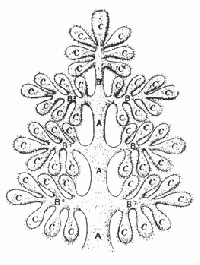Raza-Raíz
Raza-Raíz es un concepto Teosófico que se refiere a las sucesivas etapas evolutivas a través de las cuales la humanidad va en su peregrinaje en nuestro plano físico. Siete de tales razas-raíces tienen lugar antes de completar el ciclo evolutivo en este globo, la Tierra.
NOTA: El termino Raza-Raíz no se refiere a conceptos étnicos o raciales del mundo moderno.
Descripción general
En la visión Teosófica hay siete Razas-Raíces o ciclos evolutivos a través de los cuales la humanidad evoluciona. H.P. Blavatsky escribió:
Cada ciclo de vida en el Globo D (nuestra Tierra) se compone de siete razas raíz. Comienzan con lo Etéreo y terminan con lo espiritual en la doble línea de evolución física y moral, desde el comienzo de la ronda terrestre hasta su fin. (Uno es una “ronda planetaria” del Globo A al Globo G, el séptimo; el otro, la “ronda del globo”, o la terrestre).[1]
blockquote>
- Hay siete RONDAS en cada manvantara; ésta es la Cuarta, y nosotros estamos en la Quinta Raza-Raíz, en la actualidad.
- Cada Raza-Raíz tiene siete su-brazas.
- Cada sub-raza tiene, a su vez, siete ramificaciones, que pueden llamarse Ramas o razas “Familiares”.
- Las pequeñas tribus, brotes y ramificaciones de estos últimos son innumerables y dependen de la acción Kármica.
Examine el “árbol genealógico” adjunto a la presente, y comprenderá. La ilustración es puramente esquemática y solo pretende ayudar al lector a obtener una ligera comprensión del tema. . . .
El tallo principal de un árbol puede compararse con la raza-raíz (A).
Sus miembros más grandes a las diversas sub-razas; siete en número (B1, B2).
En cada uno de estos miembros hay siete ramas o razas-familiares (C).
After this the cactus-plant is a better illustration, for its fleshy “leaves” are covered with sharp spines, each of which may be compared to a nation or tribe of human beings.[2]
Seven Root-Races
The Root-Races go through a process of cyclic evolution going from subtlety to materiality and back to subtlety:
These Races evolve from ethereality to materiality, and from the latter back again into relative physical tenuity of texture, so every living (so-called) organic species of animals with vegetation included, changes with every new Root-Race.[3]
Let us remember that the First Race is shown in Occult sciences as spiritual within and ethereal without; the second, psycho-spiritual mentally, and ethero-physical bodily; the third, still bereft of intellect in its beginning, is astro-physical in its body, and lives an inner life, in which the psycho-spiritual element is in no way interfered with as yet by the hardly nascent physiological senses.[4]
These cycles take place throughout the seven Rounds, and they vary in length:
The seven Rounds decrease and increase in their respective durations, as well as the seven races in each. Thus the 4th Rounds as well as every 4th race are the shortest, while the 1st and 7th Rounds as the 1st and 7th root races are the longest.[5]
It is important to keep in mind that the term Root-Races does not refer to ethnicities. They are different evolutionary stages humanity as a whole goes through successively. Bes
- ↑ Helena Petrovna Blavatsky, La Doctrina Secreta vol. I, (Wheaton, IL: Theosophical Publishing House, 1993), 160.
- ↑ Helena Petrovna Blavatsky, The Secret Doctrine vol. II, (Wheaton, IL: Theosophical Publishing House, 1993), 434-435.
- ↑ Helena Petrovna Blavatsky, The Secret Doctrine vol. II, (Adyar, Madras: Theosophical Publishing House, 1979), 697.
- ↑ Helena Petrovna Blavatsky, The Secret Doctrine vol. II, (Wheaton, IL: Theosophical Publishing House, 1993), 298-299, fn.
- ↑ Helena Petrovna Blavatsky, Collected Writings vol. VI (Wheaton, IL: Theosophical Publishing House, 1989), 117.
